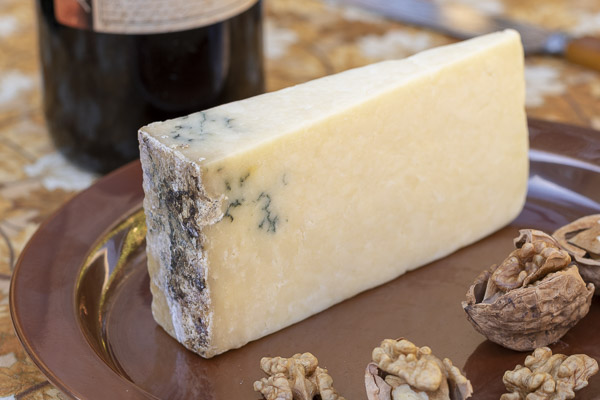A wedge of English Cheddar I purchased recently had a few threads of blue mold inside, the result of a breach in the rind. The blue didn’t deter me—the cheese tasted great—but I knew many shoppers would eye the piece and put it back. I asked the clerk how she talks to customers who flinch at the sight of blue veins in a Cheddar. “I tell them it’s been kissed by mold,” she said. I like that.
I know from questions in my classes that many consumers are mold-phobic. They spot blue dots on a Brie and want to toss the whole thing. “I throw out moldy food,” one student told me. “Why is moldy cheese okay?” For an expert answer, I turned to Benjamin Wolfe, a mold enthusiast.
Mold whisperer: Benjamin Wolfe
Wolfe is an assistant professor in the biology department at Tufts University and head of the Wolfe Lab, where molds get close scrutiny. Wolfe and his colleagues study cheese rinds to understand how microbial communities develop and interact. I knew he would have some moldy insights.
All of us have gone through our fridge and tossed out moldy food. So why do we tolerate molds on cheese?
In many ways, it depends on the type of cheese. Cheeses like Camembert and Brie have been intentionally inoculated with fungi that have been selected over many years and domesticated to deliver beneficial properties. We know these molds are safe and don’t produce toxins. The molds on cheese are beneficial molds, unlike the molds that spoil food and can be making toxins.
Do you divide your world into good molds and bad molds? Is it that binary?
Good molds in the wrong place could be considered bad. For example, some cheesemakers have issues with Penicillium roqueforti, the blue mold in blue cheese, growing in undesirable places. It can get into certain Cheddars and cause blue veins. (See the Cheddar-like Kirkham’s Lancashire pictured above.) It’s delicious but it’s not supposed to be there. I’ve talked to some Cheddar makers who want to have the blue mold, and when they try they can’t get it.
Some people view molds as bad for the wrong reason. There’s a beautiful red-orange mold, Sporendonema casei, that grows on some natural-rind cheeses. To many people, it looks bad. But there’s no known danger from this mold and many consider it desirable on cheese rinds.
Sporendonema casei growing on cheeses from Wisconsin (left), France (center) and the UK (right).
Photo: Benjamin Wolfe
Any guess at how many different species of mold grow on cheese?
That’s something we’re trying to figure out. We’re learning more about the main groups of fungi, but we don’t know the number of species yet. Penicillium, which is a very important group, is rapidly evolving in cheesemaking facilities, so it’s hard to put a number on the species. We’re finding that as molds start to grow, they’re essentially being domesticated and changing from wild molds with funky colors to much more tame molds that create flavors in cheese.
What would YOU not eat?
There is a group of molds that are particularly problematic: Aspergillus. The good thing is, they like it warm and most cheese-aging facilities are quite cold. Aspergillus can make potent mycotoxins, and occasionally I will see them on a cheese. One group of Aspergillus creates a black flakiness that looks like a crust on clothbound Cheddar or long-aged natural-rind cheeses, but other molds can create black spots that are not toxic and not concerning. So you can’t say, “If there’s black mold on your cheese, then it’s bad.” The challenge with molds is that there’s no clear set of rules for the consumer.
What about mold on cheese that isn’t supposed to have any, like cottage cheese or ricotta or a fresh goat cheese?
That can be a concern because it suggests contamination in the packaging or aging environment. There could be a problem beyond mold. I would throw those cheeses away.
The mold suggests that the product has been exposed to an environment that allows the microbes to colonize. Whatever that exposure was, it’s likely that bacteria were there as well. It doesn’t mean they are pathogens, but something went wrong during production. The product was exposed to conditions it shouldn’t have been in. The mold is just the visible thing.
Like the canary in the coal mine?
Exactly.
But mold on the cut side of a mold-ripened cheese, like a wedge of Brie?
If there’s a little bit, you can cut it off. That’s what I would do. In the U.S., we generally expect a white rind to be pure white and not have blemishes, but little blue spots on bloomy rinds are not usually present in high-enough amounts to cause problems. If you had a Camembert that was engulfed with blue mold, that would be questionable. That’s a lot of unknown mold growing where it shouldn’t be growing.
A dairy scientist once told me that there were no reports in the scientific literature of cheese molds that were harmful to humans. He said that they could, in theory, grow on cheese but they don’t. Do you agree?
There are not any well-documented reports of people getting sick from mold on cheese. That said, we know there can be mycotoxin-producing fungi in cheese but, generally speaking, we don’t have major issues with cheese mold.
● ● ●
Want to know more about some of the molds that may be growing on your cheese? Download this visual guide, prepared by Benjamin Wolfe.



